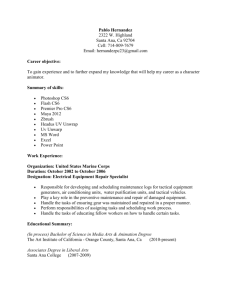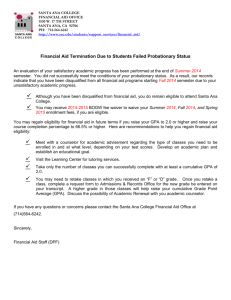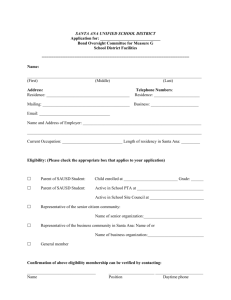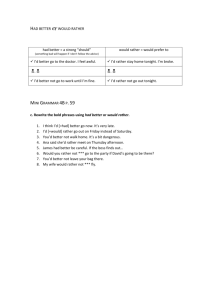Supplementary material
advertisement
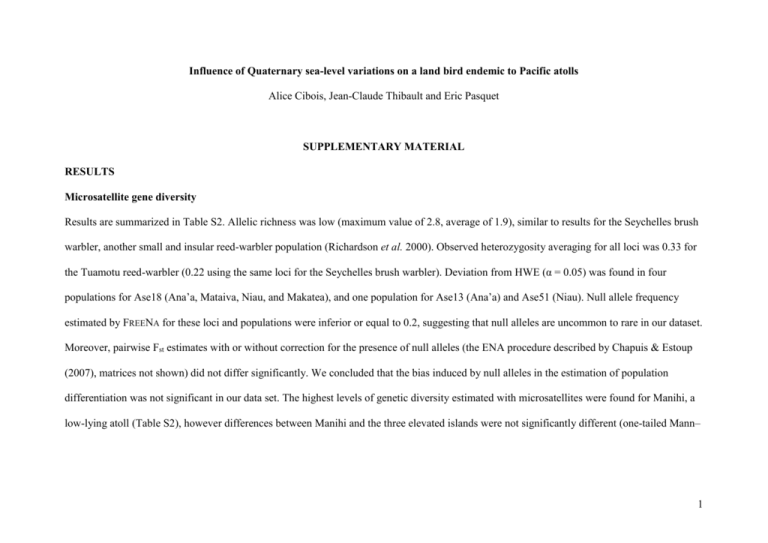
Influence of Quaternary sea-level variations on a land bird endemic to Pacific atolls Alice Cibois, Jean-Claude Thibault and Eric Pasquet SUPPLEMENTARY MATERIAL RESULTS Microsatellite gene diversity Results are summarized in Table S2. Allelic richness was low (maximum value of 2.8, average of 1.9), similar to results for the Seychelles brush warbler, another small and insular reed-warbler population (Richardson et al. 2000). Observed heterozygosity averaging for all loci was 0.33 for the Tuamotu reed-warbler (0.22 using the same loci for the Seychelles brush warbler). Deviation from HWE (α = 0.05) was found in four populations for Ase18 (Ana’a, Mataiva, Niau, and Makatea), and one population for Ase13 (Ana’a) and Ase51 (Niau). Null allele frequency estimated by FREENA for these loci and populations were inferior or equal to 0.2, suggesting that null alleles are uncommon to rare in our dataset. Moreover, pairwise Fst estimates with or without correction for the presence of null alleles (the ENA procedure described by Chapuis & Estoup (2007), matrices not shown) did not differ significantly. We concluded that the bias induced by null alleles in the estimation of population differentiation was not significant in our data set. The highest levels of genetic diversity estimated with microsatellites were found for Manihi, a low-lying atoll (Table S2), however differences between Manihi and the three elevated islands were not significantly different (one-tailed Mann– 1 Whitney test on the observed heterozygosity, n1 = n2 = 6; Manihi – Makatea U = 18, P = 0.47; Manihi- Niau U = 18, P = 0.47; Manihi – Ana’a U = 15, P = 0.35). Structure analysis The posterior probability of the data given each K (five replicates) is shown in Fig. S1. IMA analysis Divergence times under an isolation model between the three pairs of uplifted islands (Fig. S2) were consistent over multiple runs. The combination of mtDNA and microsatellite data resulted in younger estimates, particularly in the comparisons that included Niau. Effective population size estimates were consistent among uplifted island pairs and suggested values of less than 10 000 individuals per islands (curves are shown for one pair of islands, Makatea- Ana’a, Fig. S3). These estimates are compatible with the small size of these islands (Table S1). REFERENCES Andréfouët, S., Chauvin, C., Spraggins, S., Torres-Pulliza, D. & Kranenburg, C. 2005 Atlas des récifs coralliens de Polynésie française. Nouméa: Centre IRD. Chapuis, M.-P. & Estoup, A. 2007 Microsatellite null alleles and estimation of population differentiation. Mol. Biol. Evol. 24, 621-631. 2 Richardson, D. S., Jury, F. L., Dawson, D. A., Salgueiro, P., Komdeur, J. & Burke, T. 2000 Fifty Seychelles warblers (Acrocephalus sechellensis) microsatellite loci polymorphic in Sylviidae species and their cross-species amplification in other passerine birds. Mol. Ecol. 9, 2155-2234. Supplementary figure legends Figure S1: Mean likelihood L(K) (± SD) over five runs for each K value. Figure S2: Posterior probabilities for divergence times between the three uplifted islands, with mtDNA only (left) and combined with microsatellites data (right), estimated with IMA. Figure S3: Posterior probabilities for population size estimates for Ana’a (q1), Makatea (q2), and their hypothetical ancestral species (qa), estimated with IMA. Peak values reach 8000 individuals for Ana’a and 7000 for Makatea. 3 Supplementary table legends Table S1 : Sampling localities. Maximum elevation in metres above present sea-level, total area of land in km2 (Andréfouët et al. 2005). Table S2 : Microsatellite genetic diversity of Tuamotu reed-warbler populations. Sample size (N), allelic richness (A), observed and expected heterozygosity (HO and HE). See Richardson et al. (2000) for the Seychelles brush warbler data. Table S3: Proportion of membership of each pre-defined population in each of the five clusters found with STRUCTURE. The three groups that correspond to uplifted islands are indicated in bold. Table S4: Estimates of migration rates (m, proportion of population) among 10 populations of Tuamotu reed-warbler using BAYESASS. Values on the diagonal (in bold) are the proportion of individuals derived from the source population each generation. No estimate of m was significantly different from zero (95% confidence interval, indicated in parenthesis, includes zero). 4 Table S1 Atolls Elevation (m) Area (km2) Fa’aite ≤3 11.31 Takapoto ≤3 15.48 Ana’a 5 44.32 Makatea 113 28.36 Napuka ≤3 9.85 Hao ≤3 40.10 Manihi ≤3 20.03 Mataiva 4* 16.92 Niau 6 22.15 Tikehau 10* 29.86 * Maximum height of pre-Holocene carbonate remains, these atolls are mostly at ≤3 m above present sea-level. 5 Table S2 Average over all loci N A HO HE Fa’aite 19 2.2 0.41 0.48 Takapoto 21 1.8 0.45 0.44 Ana’a 18 2.0 0.23 0.32 Makatea 20 1.8 0.32 0.39 Napuka 10 1.8 0.42 0.43 Hao 21 1.6 0.33 0.32 Manihi 8 2.8 0.53 0.64 Mataiva 16 1.5 0.23 0.52 Niau 21 2.0 0.19 0.27 Tikehau 14 1.6 0.30 0.25 Average for Tuamotu reed-warbler 0.34 Average for Seychelles brush warbler 0.22 6 Table S3 Populations Inferred Clusters 1 2 3 4 5 Fa’aite 0.257 0.093 0.255 0.060 0.335 Takapoto 0.279 0.130 0.064 0.039 0.487 Ana’a 0.109 0.041 0.731 0.015 0.105 Makatea 0.060 0.030 0.018 0.847 0.046 Napuka 0.202 0.362 0.125 0.118 0.193 Hao 0.197 0.092 0.441 0.047 0.223 Manihi 0.347 0.110 0.064 0.142 0.337 Mataiva 0.143 0.365 0.243 0.165 0.085 Niau 0.238 0.547 0.050 0.070 0.094 Tikehau 0.217 0.122 0.048 0.139 0.473 7 Table S4 Migration from Migration into Fa’aite Takapoto Ana’a Makatea Napuka Hao Manihi Mataiva Niau Tikehau Fa’aite 0.018 0.018 0.018 0.018 0.018 0.018 0.018 0.018 0.018 0.837 (0.674, 0.990) (0.000, 0.076) (0.00, 0.083) (0.000, 0.078) (0.000, 0.084) (0.000, 0.076) (0.000, 0.078) (0.000, 0.082) (0.000, 0.078) (0.000, 0.075) Takapoto 0.018 0.831 0.019 0.019 0.018 0.019 0.019 0.018 0.018 0.019 (0.000, 0.079) (0.676, 0.992) (0.000, 0.074) (0.00, 0.080) (0.000, 0.078) (0.000, 0.077) (0.000, 0.080) (0.00 0.076) (0.00, 0.076) (0.000, 0.079) Ana’a 0.019 0.0193 0.821 0.019 0.019 0.021 0.021 0.019 0.020 0.020 (0.000, 0.077) (0.000, 0.083) (0.674, 0.988) (0.000, 0.073) (0.000, 0.076) (0.000, 0.084) (0.000, 0.086) (0.000, 0.081) (0.000, 0.079) (0.000, 0.087) Makatea 0.020 0.020 0.021 0.813 0.020 0.021 0.022 0.020 0.021 0.021 (0.000, 0.082) (0.000, 0.080) (0.000, 0.079) (0.672, 0.988) (0.000, 0.084) (0.000, 0.085) (0.000, 0.092) (0.000, 0.082) (0.000, 0.083) (0.000, 0.084) Napuka 0.019 0.018 0.019 0.019 0.829 0.019 0.019 0.019 0.019 0.018 (0.000, 0.077) (0.000, 0.073) (0.000, 0.084) (0.000, 0.082) (0.674, 0.991) (0.000, 0.075) (0.000, 0.077) (0.000, 0.079) (0.000, 0.079) (0.000, 0.079) Hao 0.020 0.020 0.021 0.020 0.020 0.816 0.021 0.020 0.020 0.020 (0.000, 0.074) (0.000, 0.078) (0.000, 0.088) (0.000, 0.080) (0.000, 0.083) (0.672, 0.985) (0.000, 0.083) (0.000, 0.077) (0.000, 0.080) (0.000, 0.077) Manihi 0.020 0.020 0.021 0.021 0.020 0.021 0.814 0.021 0.020 0.021 (0.000, 0.074) (0.000, 0.079) (0.000, 0.084) (0.000, 0.079) (0.000, 0.081) (0.000, 0.082) (0.671, 0.985) (0.000, 0.078) (0.000, 0.082) (0.000, 0.087) Mataiva 0.017 0.017 0.018 0.018 0.018 0.018 0.018 0.839 0.018 0.018 (0.000, 0.073) (0.000, 0.078) (0.000, 0.077) (0.000, 0.078) (0.000, 0.082) (0.000, 0.083) (0.000, 0.080) (0.675, 0.992) (0.000, 0.076) (0.000, 0.077) 8 Niau 0.019 0.019 0.019 0.019 0.019 0.020 0.019 0.019 0.827 0.019 (0.000, 0.077) (0.000, 0.075) (0.000, 0.081) (0.000, 0.080) (0.000, 0.087) (0.000, 0.083) (0.000, 0.083) (0.00, 0.085) (0.675, 0.990) (0.000, 0.077) Tikehau 0.019 0.019 0.020 0.020 0.019 0.020 0.020 0.020 0.020 0.821 (0.000, 0.081) (0.000, 0.080) (0.000, 0.078) (0.000, 0.085) (0.000, 0.074) (0.000, 0.087) (0.000, 0.086) (0.000, 0.087) (0.000, 0.087) (0.673, 0.989) 9


